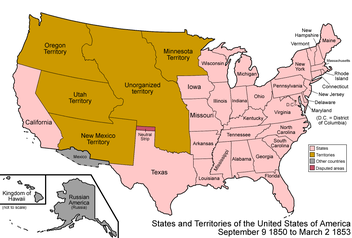
Back مساومة عام 1850 Arabic Кампраміс 1850 года Byelorussian Compromís de 1850 Catalan Kompromis roku 1850 Czech 1850-kompromiset Danish Kompromiss von 1850 German Compromiso de 1850 Spanish مصالحه ۱۸۵۰ Persian Vuoden 1850 kompromissi Finnish Compromis de 1850 French
- Northwest Ordinance (1787)
- Kentucky and Virginia Resolutions (1798–99)
- End of Atlantic slave trade
- Missouri Compromise (1820)
- Tariff of 1828
- Nat Turner's Rebellion (1831)
- Nullification crisis (1832–33)
- Abolition of slavery across British colonies (1834)
- Texas Revolution (1835–36)
- United States v. Crandall (1836)
- Gag rule (1836–44)
- Commonwealth v. Aves (1836)
- Murder of Elijah Lovejoy (1837)
- Burning of Pennsylvania Hall (1838)
- American Slavery As It Is (1839)
- United States v. The Amistad (1841)
- Prigg v. Pennsylvania (1842)
- Texas annexation (1845)
- Mexican–American War (1846–48)
- Wilmot Proviso (1846)
- Nashville Convention (1850)
- Compromise of 1850
- Uncle Tom's Cabin (1852)
- Recapture of Anthony Burns (1854)
- Kansas–Nebraska Act (1854)
- Ostend Manifesto (1854)
- Bleeding Kansas (1854–61)
- Caning of Charles Sumner (1856)
- Dred Scott v. Sandford (1857)
- The Impending Crisis of the South (1857)
- Panic of 1857
- Lincoln–Douglas debates (1858)
- Oberlin–Wellington Rescue (1858)
- John Brown's raid on Harpers Ferry (1859)
- Virginia v. John Brown (1859)
- 1860 presidential election
- Crittenden Compromise (1860)
- Secession of Southern states (1860–61)
- Peace Conference of 1861
- Corwin Amendment (1861)
- Battle of Fort Sumter (1861)
The Compromise of 1850 was a package of five separate bills passed by the United States Congress in September 1850 that temporarily defused tensions between slave and free states in the years leading up to the American Civil War. Designed by Whig senator Henry Clay and Democratic senator Stephen A. Douglas, with the support of President Millard Fillmore, the compromise centered on how to handle slavery in recently acquired territories from the Mexican–American War (1846–48).
The provisions of the compromise were:[1][2]
- approved California's request to enter the Union as a free state
- strengthened fugitive slave laws with the Fugitive Slave Act of 1850
- banned the slave trade in Washington, D.C. (while still allowing slavery itself there)
- defined northern and western borders for Texas while establishing a territorial government for the Territory of New Mexico, with no restrictions on whether any future state from this territory would be free or slave
- established a territorial government for the Territory of Utah, with no restrictions on whether any future state from this territory would be free or slave
A debate over slavery in the territories erupted during the Mexican–American War, as many Southerners sought to expand slavery to the newly acquired lands and many Northerners opposed any such expansion. The debate was further complicated by Texas's claim to all former Mexican territory north and east of the Rio Grande, including areas it had never effectively controlled. These issues prevented the passage of organic acts to create organized territorial governments for the land acquired in the Mexican–American War. In early 1850, Clay proposed a package of eight bills that would settle most of the pressing issues before Congress. Clay's proposal was opposed by President Zachary Taylor, anti-slavery Whigs like William Seward, and pro-slavery Democrats like John C. Calhoun, and congressional debate over the territories continued. The debates over the bill are among the most famous in Congressional history, and the divisions devolved into fistfights and drawn guns on the floor of Congress.
After Taylor died and was succeeded by Fillmore, Douglas took the lead in passing Clay's compromise through Congress as five separate bills. Under the compromise, Texas surrendered its claims to present-day New Mexico and other states in return for federal assumption of Texas's public debt. California was admitted as a free state, while the remaining portions of the Mexican Cession were organized into New Mexico Territory and Utah Territory. Under the concept of popular sovereignty, the people of each territory would decide whether or not slavery would be permitted. The compromise also included a more stringent Fugitive Slave Law and banned the slave trade in Washington, D.C. The issue of slavery in the territories would be re-opened by the Kansas–Nebraska Act (1854), but the Compromise of 1850 played a major role in postponing the American Civil War.
- ^ Drexler, Ken. "Research Guides: Compromise of 1850: Primary Documents in American History: Introduction". guides.loc.gov. Retrieved December 3, 2022.
- ^ "Compromise of 1850 (1850)". National Archives. June 28, 2021. Retrieved December 3, 2022.

